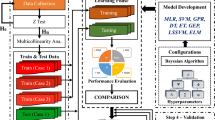Abstract
In this study, the uniaxial compressive strength (UCS) of rock samples has been predicted using a novel machine learning (ML) algorithm. The efficacy of the algorithm was evaluated by testing the same on a tiny dataset with only 47 samples as well as a large dataset with 170 samples. The UCS of rock samples has some outlier points in the dataset. It is well known that the samples are equally responsible for the end regressor in the case of random forest (RF), extreme learning machine (ELM), least squares support vector regression (LSSVR) primal least squares twin SVR (PLSTSVR), and even few of them act as outliers. Due to this, the prediction performance may degrade. In this study, a new density weighted approach for PLSTSVR is proposed as density weighted least squares twin support vector regression (PDWLSTSVR) in primal space, to deal with input samples in the presence of outliers. Hence, it boosts the performance of PDWLSTSVR in terms of efficiency. Here, the weights are determined with the help of k–Nearest Neighbour (k–NN) distance. Further, the proposed PDWLSTSVR is applied to real-world application like the prediction of the UCS of rock samples. To assess the competence of the proposed PDWLSTSVR, the performance of the models is tested based on different evaluation measures like RMSE, MAE, SMAPE, MASE, SSE/SST, SSR/SST and R2. The result shows that PDWLSTSVR outperforms the RF, ELM, LSSVR and PLSTSVR in terms of all the evaluation measures.












Similar content being viewed by others
References
Armaghani DJ, Mohamad ET, Momeni E, Narayanasamy MS, Mohd Amin MF (2014) An adaptive neuro-fuzzy inference system for predicting unconfined compressive strength and Young’s modulus: a study on Main Range granite. Eng Geol Environ Bull 74:1301–1319
Armaghani DJ, Safari V, Fahimifar A, Amin MFM, Monjezi M, Mohammadi MA (2017) Uniaxial compressive strength prediction through a new technique based on gene expression programming. Neural Comput Appl 30:3523–3532
Baykasoglu A, Gullu H, Canakci H, Ozbakir L (2008) Predicting of compressive and tensile strength of limestone via genetic programming. Expert Syst Appl 35:111–112
Bieniawski ZT (1973) Engineering classification of jointed rock masses. Trans S Afr Inst Civ Eng 15:335–344
Breiman L (2001) Random forests. Mach Learn 45:5–32
Ceryan N, Can NK (2018) Prediction of the uniaxial compressive strength of rock materials. Handbook of research on trends and digital advances in engineering geology. IGI Global, Pennsylvania, pp 31–96
Ceryan N, Samui P (2020) Application of soft computing methods in predicting uniaxial compressive strength of the volcanic rocks with different weathering degree. Arab J Geosci 13:288
Dindarloo SR, Siami-Irdemoosa E (2016) Estimating the unconfined compressive strength of carbonate rocks using gene expression programming. Europ J Sci Res 135(3):309–316
Dudani SA (1976) The distance-weighted k-nearest neighbor rule. IEEE Tran Syst Man Cyb 6:325–327
Gul E, Ozdemir E, Sarici DE (2021) Modeling uniaxial compressive strength of some rocks from Turkey using soft computing techniques. Measurement 171:108781
Hazarika BB, Gupta D (2021) Density-weighted support vector machines for binary class imbalance learning. Neural Comput Appl 33(9):4243–4261
Hazarika B, Gupta D, Berlin M (2020) Modeling suspended sediment load in a river using extreme learning machine and twin support vector regression with wavelet conjunction. Environ Earth Sci 79:234
Huang G-B, Zhu Q-Y, Siew C-K (2004) Extreme learning machine: a new learning scheme of feedforward neural networks. In: Proceedings of international joint conference on neural networks (IJCNN2004), vol 2, Budapest, Hungary, 25–29 July 2004, pp 985–990
Huang H-J, Ding S-F, Shi Z-Z (2013) Primal least squares twin support vector regression. J Zhe Uni Sci 14(9):722–732
Kahraman S (2014) The determination of uniaxial compressive strength from point load strength for pyroclastic rocks. Eng Geol 170:33–42
Li W, Tan Z (2017) Research on rock strength prediction based on least squares support vector machine. Geotech Geol Eng 35:385–393
Mahmoodzadeh A, Mohammadi M, Ibrahim HH, Abdulhamid SN, Salim SG, Ali HFH, Majeed MK (2021) Artificial intelligence forecasting models of uniaxial compressive strength. Transp Geotech 27:100499
Mohamad ET, Armaghani DJ, Momeni E, Abad SVNK (2015) Prediction of the unconfined compressive strength of soft rocks: a PSO-based ANN approach. Bull Eng Geol Environ 74:745–757
Pao Y-H, Takefuji Y (1992) Functional-link net computing: theory, system architecture, and functionalities. Computer 25(5):76–79
Rezaei M, Majdi A, Monjezi M (2014) An intelligent approach to predict unconfined compressive strength of rock surrounding access tunnels in longwall coal mining. Neural Comput Appl 24(1):233–241
Shahsavar A, Bagherzadeh SA, Mahmoudi B, Hajizadeh A, Afrand M, Nguyen TK (2019) Robust weighted least squares support vector regression algorithm to estimate the nanofluid thermal properties of water/graphene oxide–silicon carbide mixture. Phys A 525:1418–1428
Suykens JAK, Vandewalle J (2000) Recurrent least squares support vector machines. IEEE Trans Circuits Syst I: Fundam Theory Appl 47(7):1109–1114
Wang M, Wan W, Zhao Y (2020) Prediction of the uniaxial compressive strength of rocks from simple index tests using a random forest predictive model. Comptes Rendus Mecanique 348(1):3–32
Yagiz S, Gokceoglu C (2010) Application of fuzzy inference system and non-linear regression models for predicting rock brittleness. Expert Syst Appl 37:2265–2272
Funding
No funding was received.
Author information
Authors and Affiliations
Corresponding author
Ethics declarations
Conflict of interest
The authors declare that they have no conflict of interest.
Additional information
Publisher's Note
Springer Nature remains neutral with regard to jurisdictional claims in published maps and institutional affiliations.
Rights and permissions
About this article
Cite this article
Gupta, D., Natarajan, N. Prediction of uniaxial compressive strength of rock samples using density weighted least squares twin support vector regression. Neural Comput & Applic 33, 15843–15850 (2021). https://doi.org/10.1007/s00521-021-06204-2
Received:
Accepted:
Published:
Issue Date:
DOI: https://doi.org/10.1007/s00521-021-06204-2




